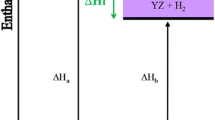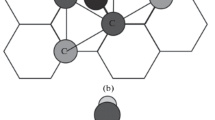Abstract
Data presented in metal-hydrogen phase diagrams are summarized for metals that normally do not form hydrides. At high temperatures, all systems of this sort are characterized by a gas-eutectic equilibrium. The gas-cutectic transformation is analyzed in detail. It is shown that this transformation generates various gas-solid structures. Porous materials produced as a result of gas-eutectic reactions have numerous advantages over traditional materials. We call this family of new porous materials gasars.
Similar content being viewed by others
References
V. I. Shapovalov,Influence of Hydrogen on the Structure and Properties of Iron-Carbon Alloys [in Russian], Metallurgiya, Moscow (1982).
V. I. Shapovalov, “Hydrogen as an alloying element,”Metalloved. Term. Obrab. Met., No. 8, 13–17 (1985).
V. I. Shapovalov and N. P. Serdyuk, “Some thermodynamic characteristics of the nickel-hydrogen and cobalt-hydrogen systems,”Zh. Fiz. Khim., No. 9, 2187–2191 (1979).
V. I. Shapovalov, N. P. Serdyuk, and V. I. Dolzhenkov, “Phase diagram of the chromium-hydrogen system,”Dokl. Akad. Nauk Ukr. SSR, No. 3, 88–90 (1981).
N. P. Serdyuk and V. I. Shapovalov, “Phase diagram of the manganese-hydrogen system,”Izv. Vyssh. Uchebn. Zaved., Chern. Metallurg., No. 8, 70–74 (1982).
V. I. Shapovalov, N. P. Serdyuk, and A. P. Semik, “Phase diagrams of the magnesium-hydrogen and aluminum-hydrogen systems,”Dokl. Akad. Nauk Ukr. SSR, No. 6, 102–105 (1981).
V. I. Shapovalov and N. P. Serdyuk, “Phase diagram of the copper-hydrogen system,”Izv. Vyssh. Uchebn. Zaved., Tsvet. Metallurg., No. 2, 151–154 (1980).
V. I. Shapovalov and Yu. M. Dukel'skii, “Phase diagram of the beryllium-hydrogen system,”Izv. Akad. Nauk SSSR, Metally, No. 5, 201–203 (1988).
V. I. Shapovalov and V. G. Kutsinskii, “Phase diagrams of the molybdenum-hydrogen and tungsten-hydrogen systems,”Dokl. Akad. Nauk Ukr. SSR, No. 11, 85–87 (1988).
V. I. Shapovalov, N. P. Serdyuk, and A. L. Titkov, “Phase diagram of the titanium-hydrogen system,”Izv. Vyssh. Uchebn. Zaved., Tsvet. Metallurg., No. 6, 74–78 (1983).
V. I. Shapovalov, A. P. Semik, and A. G. Timchenko, “On the solubility of hydrogen in liquid magnesium,”Metally, No. 3, 25–28 (1993).
R. M. Gabidullin, B. A. Kolachev, and L. N. Zhuravlev, “On the relationship between isobars of solubility and phase diagrams of gas-metal systems,”Izv. Vyssh. Uchebn. Zaved., Tsvet. Metallurg., No. 3, 112–117 (1975).
V. I. Shapovalov,Method for Manufacturing Porous Articles, U.S. Patent; No. 5181549, 26 Jan. 1993, B22D 27/13.
M. Maquire, “Porous materials have high strength, stiffness,”Adv. Mater. Proc. 145, No. 1, 20 (1994).
V. I. Shapovalov and V. Yu. Karpov, “The phenomenon of appearance of mobile hydrogen-saturated metastable zones in the process of polymorphic transformation of metals,”Byul. Otkryt. Izobr., No. 3, 1986, Diploma No. 313.
V. I. Shapovalov and V. Yu. Karpov, “On the nature of anomalous spontaneous deformation and quasiliquid states of some metal-hydrogen system,”Fiz.-Khim. Mekh. Mater. 20, No. 3, 41–45 (1984).
Additional information
State Metallurgical Academy of the Ukraine, Dnepropetrovsk. Translated from Fiziko-Khimicheskaya Mekhanika Materialov, Vol. 30, No. 4, pp. 24–30, July – August, 1994.
Rights and permissions
About this article
Cite this article
Shapovalov, V.I. Prospects of the application of hydrogen as an alloying element. Mater Sci 30, 419–423 (1995). https://doi.org/10.1007/BF00558833
Received:
Issue Date:
DOI: https://doi.org/10.1007/BF00558833




